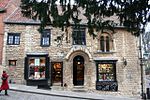Siege of Lincoln
1644 in England17th century in LincolnshireConflicts in 1644History of Lincoln, EnglandMilitary history of Lincolnshire ... and 2 more
Sieges of the English Civil WarsSource attribution

The siege of Lincoln took place from 3 to 6 May 1644 during the First English Civil War, when the important town of Lincoln was besieged by Parliamentarian forces under the Earl of Manchester. On the first day, the Parliamentarians took the lower town. The Royalist defenders retreated into the stronger fortifications of the upper town, which encompassed and incorporated Lincoln Castle and Lincoln Cathedral. The siege ended four days later when the Parliamentarian soldiers stormed the castle, taking prisoner the Royalist governor, Sir Francis Fane, and what remained of his garrison.
Excerpt from the Wikipedia article Siege of Lincoln (License: CC BY-SA 3.0, Authors, Images).Siege of Lincoln
Exchequergate, Lincoln New Boultham
Geographical coordinates (GPS) Address Nearby Places Show on map
Geographical coordinates (GPS)
| Latitude | Longitude |
|---|---|
| N 53.2344 ° | E -0.5386 ° |
Address
Exchequergate 1
LN2 1PZ Lincoln, New Boultham
England, United Kingdom
Open on Google Maps











